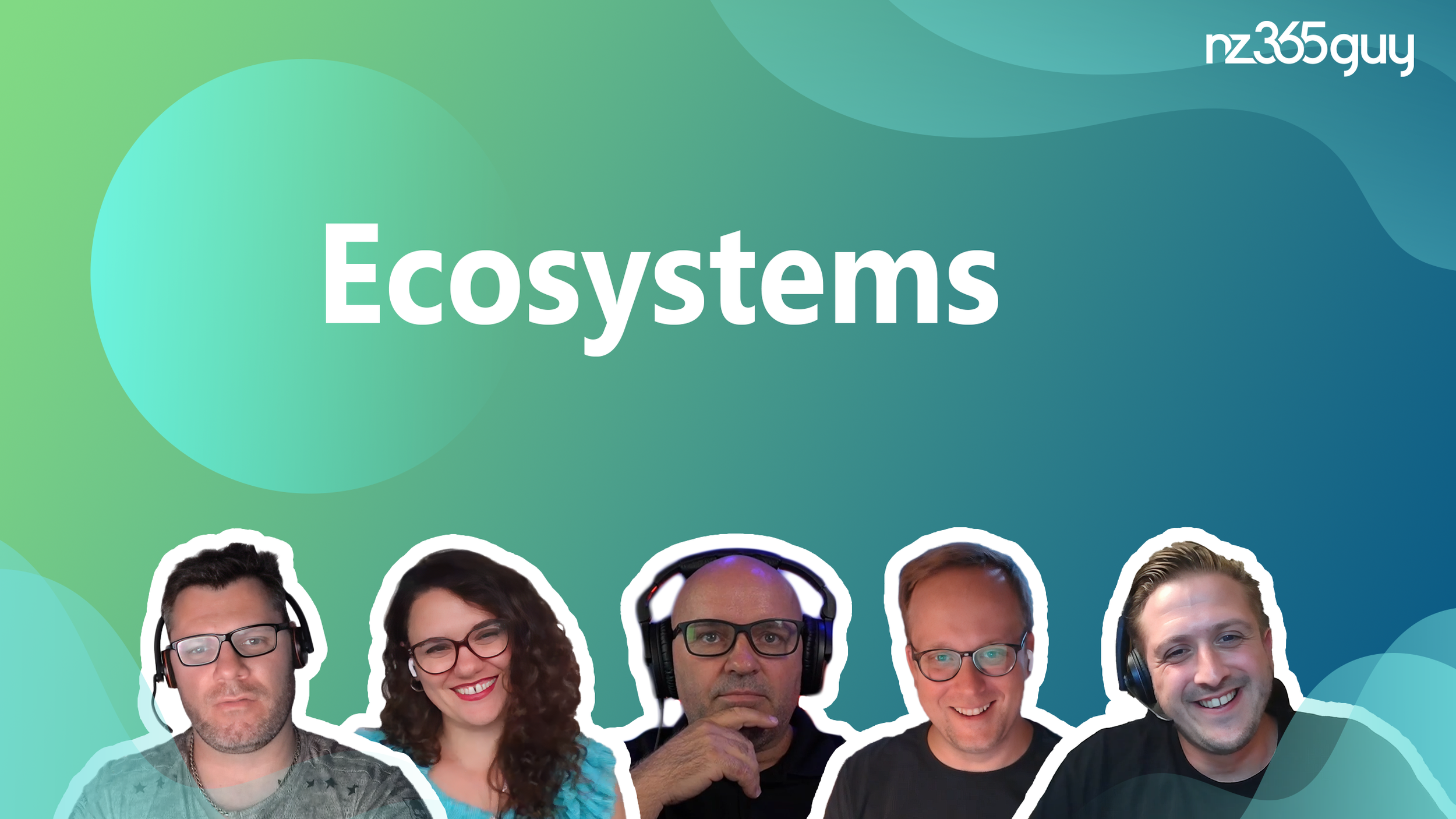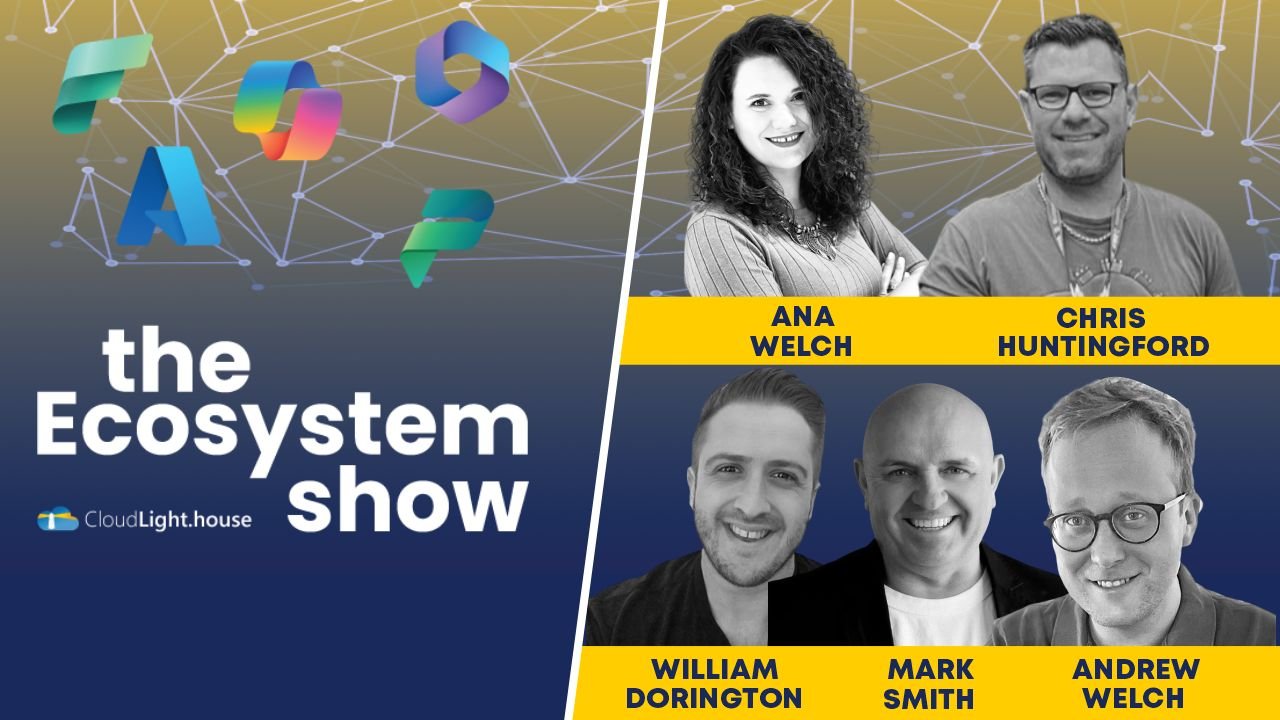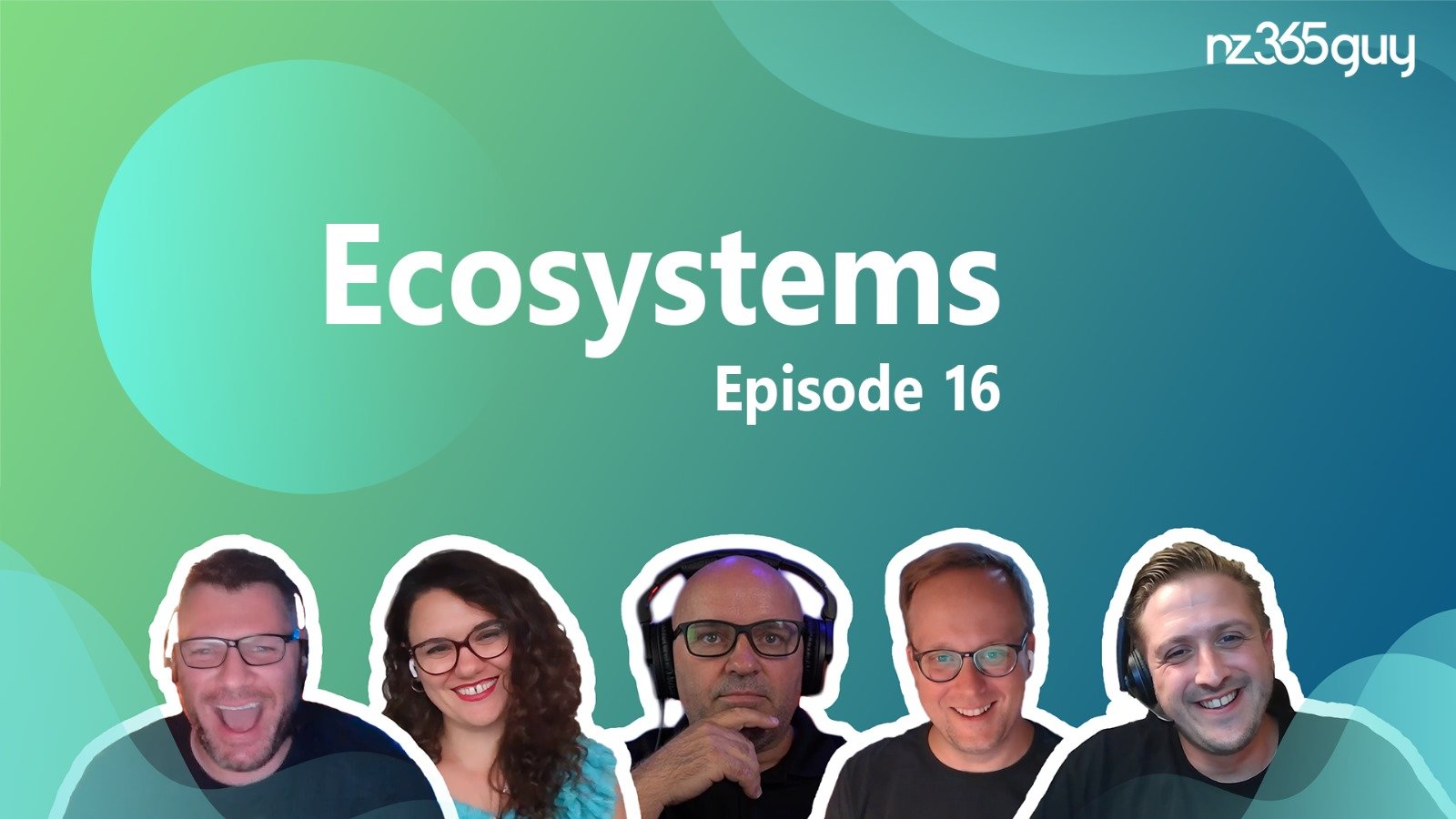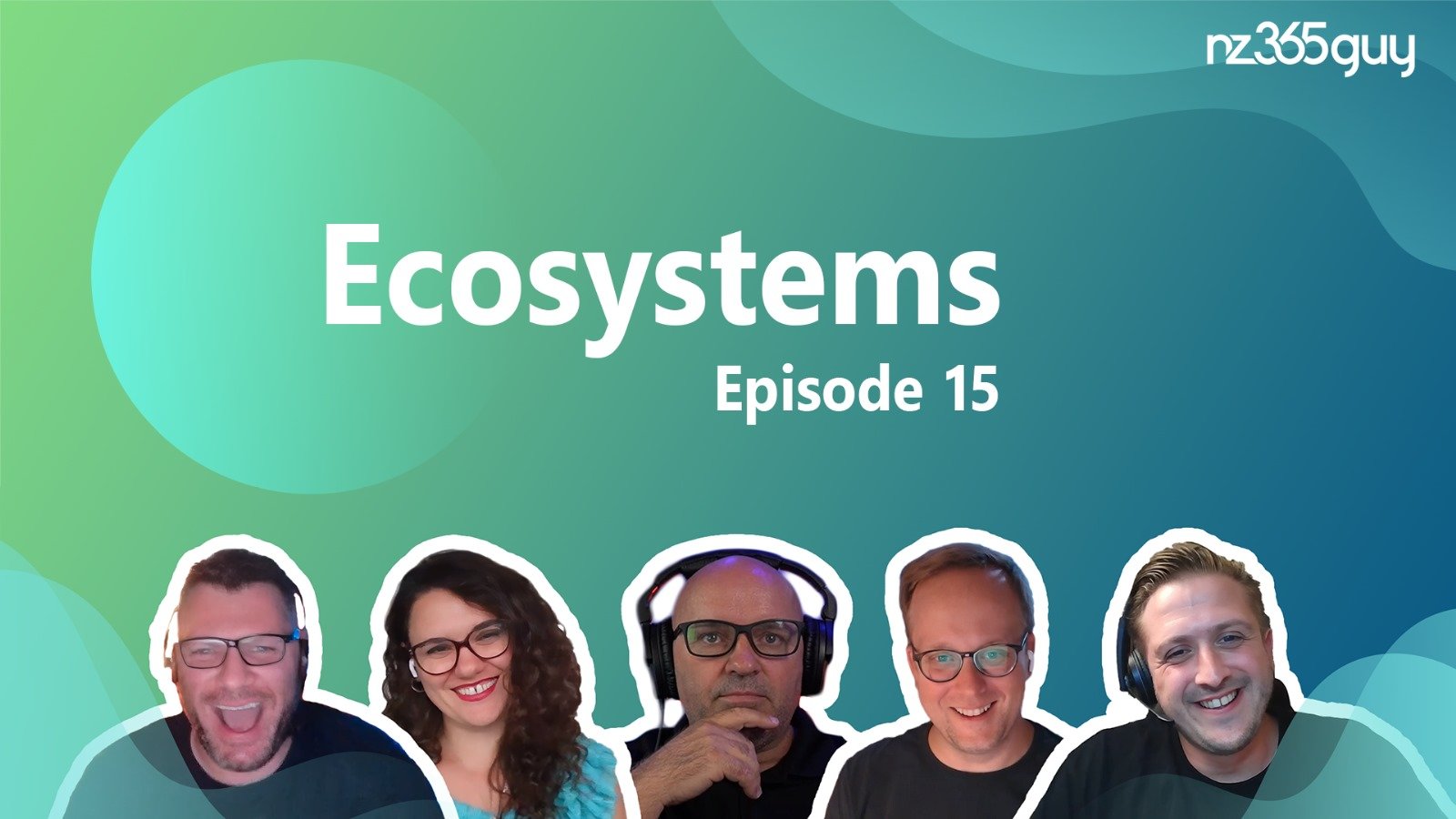
Ecosystems Podcast
Cloud ecosystems built on strategic foundations create the conditions to absorb successive waves of change
Ecosystems is the collaboration of Mark Smith (LinkedIn | Twitter), Ana Demeny (LinkedIn | Twitter), Chris Huntingford (LinkedIn | Twitter), Will Dorrington (LinkedIn | Twitter), and Andrew Welch (LinkedIn | Twitter). We’re enabling the global Microsoft community to build vibrant cloud ecosystems across Azure, Power Platform, Fabric, M365, and D365.
Technological advancements in this space are now moving on timelines that in some instances can be measured in weeks. Not months. Not years. But weeks. This both accelerates and is accelerated by the shift to ecosystem-oriented architecture and the adoption of artificial intelligence. In other words, getting the platform ecosystem right in an organization is both necessary to creating the greatest likelihood that the organization can absorb rapid change, whilst simultaneously creating the conditions that drive rapid innovation forward. Your cloud ecosystem is the catalyst for your future-ready organization.
But the IT industry faces a major challenge in that too many people and organizations are focused on the wrong things. Or, to be more precise, too many organizations have misallocated their focus, prioritizing workload implementation either at the expense of or out of ignorance to architecting strategic foundations, building the platform ecosystem, and creating the conditions for success. Too much energy remains focused on building apps ‘n stuff, and not enough energy is devoted to accelerating the building of apps ‘n stuff in an exponential way.
In this engaging conversation, the hosts delve into the importance of red teaming in AI development and the necessity of legal considerations in this evolving landscape. They explore the manipulation of AI models, particularly focusing on large language models (LLMs) and the ethical implications of such actions. They discuss the importance of red teaming in cybersecurity and the need for greater awareness of security risks in the business world as well as touching on the future of AI in business.
The conversation covers recent US AI policies, highlighting responsible adoption. It compares US and European policy perspectives, then shifts to global AI competition, especially with China. The speakers discuss nationalism, AI's global impact, tech limitations, the role of memory, and delegation in AI systems. They also touch on Microsoft's Copilot and the need for clear messaging in the AI space.
The recent MVP Summit is examined, with a focus on Microsoft's evolving AI strategy and the implications of their Fabric platform. The future of business applications at Microsoft, the changing relationship between technology and legal considerations, and the importance of trust and governance in AI are explored. Additionally, the human rights implications of AI and the necessity for a more robust ethical framework as technology continues to advance are discussed.
The conversation covers a range of topics on creative design and branding for AI technology, concerns about human rights in AI, reflections on recent AI events, and the disconnect between AI technology creators and sellers regarding trustworthy AI. The participants emphasize the importance of innovation while maintaining awareness of ethical considerations in AI development. In this conversation, we explore the multifaceted implications of AI, emphasizing the need for a balance between innovation and ethical considerations. We discuss the potential underhyping of AI's capabilities, the socio-economic impacts on jobs, and the importance of education and awareness in navigating the evolving landscape of technology. The conversation highlights the risks associated with AI, including its capacity for surveillance and the necessity for trustworthy practices in its development.
Various aspects of Trustworthy AI are examined, including the challenges of scaling AI solutions, the regulatory landscape surrounding AI, and the exploration of new AI tools and applications. Insights are shared on current projects, the importance of risk management in AI, and the potential impact of regulations on AI development and deployment.
The evolving landscape of artificial intelligence (AI) is examined in this latest episode, emphasizing the significance of trustworthy AI, the imperative for critical thinking, and the cultural variances in education that influence cognitive abilities. The importance of questioning in effective communication and the necessity of addressing misinformation within the technology sector are underscored.
Additionally, the recent UK government documents on AI highlight the critical need to comprehend AI legislation, the essential skills and training required in the AI domain, and the innovative opportunities that AI presents. The legal ramifications of implementing AI solutions are explored, stressing the need for legal oversight and the importance of adhering to trustworthy AI practices to safeguard customer data.
Harnessing technology can help us achieve greater success whilst prioritizing health, to achieve more in less time. For example, creating a personalized GPT to track supplement intake or using tools that recommend optimal focus times based on our chronotype, emphasizing the importance of routine and minimalism. Understanding our productivity patterns and the impact of our health on achieving goals is significant, and and important focus for all.
2025 is the year of Trustworthy AI as organizations worldwide deploy AI-enthused solutions with limited consideration on how to make it safe. Not only from a compliance and risk management perspective, but by creating AI that users themselves can trust. Trustworthy AI is top of mind for many people, though there is currently no standard approach to articulating what this means. Can we trust the results? Can we trust that AI is safely used? Is AI going to take our jobs? Will AI grow a personality and conquer the world by turning a society of toasters against us? To truly address this, it must be recognised that Trustworthy AI is more than red teaming, or testing against responsible pillars of AI. It’s about creating a trustworthy experience grounded in good data, exposing cumulative human error and AI hallucinations through technical monitoring and human observability. It’s about building a digital ecosystem that is strategic, responsible, safe, reliable and scalable. It’s about making AI a trusted enabler for humans.
Reflecting on 2024, it’s clear that AI has landed and officially taken on the ‘shiny object effect’. With organizations rushing to utilize the technology, there’s been a tendency to layer AI atop an ecosystem without establishing a strategy for the fundamentals, such as data platform, data consolidation and modernization. A hope for 2025 is the normalization of AI to avoid this, and the progression of autonomous agents that learn and mimic human communication preferences, advancing beyond basic chatbots to more immersive and context-aware AI agents.
Additionally, this past year has made it apparent that not all organization’s are creating conditions for hiring across boarders, and allowing top talent to work on key projects regardless of their geographic location. A shift in this would provide multiple benefits: simplifying projects whilst widening the talent pool, supporting the freedom of dedicated workers, and releasing brain power and capital in areas that will benefit from economic growth.
In this episode, Ana, Andrew, and Chris discuss various themes including the technical difficulties faced during remote recordings, the influence of technology on elections, the challenges of cybersecurity, and the complexities of data integration and security. They also explore how algorithms shape political messaging and the implications of these technologies on society. In this conversation, the speakers discuss various themes including the impact of social media on public perception, insights gained from major conferences like Ignite, the evolution of podcasting in the tech space, and the importance of ecosystem-oriented architecture in organizations. They emphasize the need for a clear vision and cultural readiness for successful transitions in technology and business strategies.
Microsoft Ignite 2024 featured over 200 AI sessions. Key announcementsincluded Azure SQL transactional databases for app development, Co-pilot Studio in Power Apps for mini agents, deeper RAG capabilities with Azure AI Foundry, new managed security and operations in Power Platform, and updated governance and licensing for Co-pilot Studio.This podcast episode also tackles the rise of shadow AI, emphasizing the need for governance as 78% of workers use unsanctioned tools. Beyond the tech, it reflects on the joy of hands-on collaboration, like data modelling and brainstorming on whiteboards, proving that going back to basics can still drive innovation. What’s your top Ignite takeaway?
With modern work culture emphasizing the drive for productivity and connectivity, the traditional notion of work-life balance can be challenging to achieve. In this podcast, participants share their personal experiences in trying to achieve balance, expressing the importance of setting boundaries, such as blocking calendar times for personal activities, and being clear about availability to avoid burnout. Some prefer the term "work-life integration," highlighting the need to blend work and personal life in a way that suits individual needs, with external factors, such as family responsibilities and societal expectations of workers, adding to the complexity. Hosts note differences in how men and women traditionally balance these roles, as well as personal choices and preferences playing its part, with some individuals specifically thriving in high-intensity environments. Support systems can help, such as understanding colleagues or family members, as well as business applications for task prioritization, meetings management and remote working tools, which can reduce stress help professionals set boundaries.
It is hugely important that there is trust in AI org-wide, for the successful adoption of AI. This needs human involvement and intentionality as part of a long-term AI strategy and clearly defined enablement program. Podcast listener, Rachel Roberts, comments that the need for a clear vision and planning a path towards the benefits of AI, instead of letting organic doubt take over, will build trust and reduce fears of uncertainty. She believes that being intentional can help mitigate doubts and foster trust in AI and each other. Having a strategic vision is critical and must be collectively agreed upon and championed. Ensuring that change management and training are fundamental to the effort is also essential due to the complexities of technology implementation and adoption. By combining these approaches, users can adapt, and organizations can maximize the impact of AI within their business.
European regulations are becoming more stringent, aiming to ensure AI safety, ethics, and transparency. It's therefore crucial to ground AI solutions in good data and adhere to responsible AI (RAI) standards to avoid significant fines for non-compliance. The impact of robotics on the labor market are bringing opportunities, creating task automation through rules-based agents, and evolving fully autonomous agents ready for a shift towards human oversight of agent activities. Embracing an abundance mindset can unlock these new opportunities in the evolving landscape, though there’s a necessity for digital equity, ethics and preparing data systems for future AI integration.
With organizations today using 200-300 applications, what will be the impact on users when a profusion of AI solutions are added to the pile? As vendor AI offerings continue to expand, imagine the confusion. Employees required to access multiple agents with multiple UIs, stored sporadically across their organization: an agent for HR relations, sales, service, and for vendor applications, the likes of Workday, SAP, Salesforce. A labyrinth of applications. Now imagine this simplified. Imagine all the isolated agents and their data integrated into a single UI, a single place of reference, giving clarity, accessibility and enabling high adoption. As announced by Satya Nadella, Copilot is positioning to become the new UI for AI.
In the dawn of ‘agentic’ AI, that is to say, autonomous bots capable of mimicking humans and independent decision-making, what will be the implications for our every lives? Perhaps an end to dreaded call centre dispute resolutions, instead replaced by bots tackling negotiations perfectly due to having instant access to undisputable contracts and policies, outmatching human agents. For e-commerce, AI assistants capable of re-ordering groceries online, exploiting the best discounts, fastest delivery, and lowest shipping costs, totally disrupting traditional e-commerce loyalty. Future AI has the potential to make daily life incredibly efficient and transform consumer engagement models in ways not yet fully realised.
Staggeringly, if cybercrime were a country, it would have the 3rd largest GDP. With attacks happening every second, it’s never been more important to approach data security and AI with a zero-trust mindset: practicing insider risk-management, auto-classifying data with Purview, and “red teaming” AI outputs. This critical thinking should apply to future advancements also, as we predict a shift towards observability whereby AI handles tasks and humans merely monitor them. Plus, as AI begins to mimic personas and styles, the risk of deep fakes increases, unbeknownst to users unless questioned. Staggeringly, if cybercrime were a country, it would have the 3rd largest GDP. With attacks happening every second, it’s never been more important to approach data security and AI with a zero-trust mindset: practicing insider risk-management, auto-classifying data with Purview, and “red teaming” AI outputs. This critical thinking should apply to future advancements also, as we predict a shift towards observability whereby AI handles tasks and humans merely monitor them. Plus, as AI begins to mimic personas and styles, the risk of deep fakes increases, unbeknownst to users unless questioned.
As AI systems become more integrated into our daily lives, it’s never been more critical to ensure they operate ethically. There are significant risks if not governed properly through informed practices, making responsible app development not just a necessity, but a cornerstone for building trustworthy AI systems that adhere to ethical standards and regulatory requirements. When an organization upholds this commitment, it not only mitigates potential harms but also fosters trust among users and stakeholders, thereby establishing the foundations for long-term success.
the Power Platform: Why Free is not Cheaper.” Get a behind-the-scenes update on the current and upcoming “Learn” courses, and hear from the authors about the insights behind the first verticalized view of Ecosystem-Oriented Architecture in the Public Sector, as well as the exciting release of the new AI Strategy Framework.
Is the business value toolkit simply “another tool” attempting to explain away a leader’s decision-making in some quantifiable fashion; freeing them from the responsibility of taking action in the absence of data?
Or, does it provide a true measurement of impact, helping IT tell a compelling story of ROI? Aligning with the organization’s concepts of what “true value” means to them?
“So, here’s this company that has gone to the legal trouble to rename itself with ‘AI’ in the name, but doesn’t actually know what the thing it’s now named after is.”
There’s such extraordinary noise around AI right now, but this comes with a big dose of snake oil where every company is suddenly claiming to be an AI expert. How do organizations navigate the maze and separate the real from the hype?
Every organization on the planet ought to be thinking through its game plan for AI. But is AI on the radar of people and organizations outside the tech industry? Many have tried a proof of concept, but many have not progressed beyond that. How do we uncover scenarios where AI can really help an organization?
It’s very difficult to build a data platform today that reaches its full potential without also building Power Platform into that data platform. Power Platform’s greatest value lies not in the app, but in the data the app collects or serves back to its users. Power Platform isn’t an app phenomenon. It’s a data phenomenon. Apps are only so useful if you’re not able to use them with your organization’s data. Andrew’s new Microsoft white paper articulates so clearly—from simple to advanced—the five patterns of data integration between Power Platform and a modern data platform backed by Azure data services and Microsoft Fabric.
Ana’s and Andrew’s two-year-old prefers Ms. Rachel to the Ecosystems Show, but we’re pressing on this week answering questions that we didn’t have time to get to during our recent live panel show at the DynamicsMinds conference. How important is Copilot in the cloud ecosystem? How do you define the boundaries of an ecosystem? Is it vendor-specific? What do we need to do to be ready for AI? Where’s the best place to start with tooling and techniques needed to build an ecosystem? More!
The Ecosystem Show comes out swinging against Ryanair, and then talks tech for this special in-person recording at DynamicsMinds 2024 in Portoroz, Slovenia 🇸🇮! Join us as we survey the Microsoft cloud technology landscape with reflections from this great conference, talking ecosystem architecture, the modern data platform, AI agents, and other announcements from Microsoft Build.
Is the age of IT partners implementing software via the venerable “IT project” over? As our tech moves faster, is the tyranny of the deliverable making traditional IT projects more and more obsolete? Many consultancies are out there trying to deliver technology using a 30-year-old “project-based” model, just as many customers are still accepting (or even seeking!) this fundamentally outdated way of doing business.
Is cloud technology generally and the Microsoft Cloud specifically evolving differently in economies with different populations? The world is much bigger (or smaller?) than the United States and Europe, so what does that mean for technology? How does geographic and population variation—and different dynamics in business culture—impact cloud ecosystems around the world?
Join Mark Smith, Andrew Welch, and Will Dorrington as they take on “anchor apps”, the essential large-scale applications crucial for organizational operations, known in ecosystem-oriented architecture as “core business systems”. These apps or “workloads” are significant, particularly compared to the many, smaller apps that are bought off the shelf or developed using tools like Microsoft Power Platform. The hosts share several of their favorite examples encountered over their time working with Power Platform across sectors and geographies, including anchor apps responsible for transportation logistics, evidence collection in law enforcement, and in military operations. Despite their importance, there’s a noted lack of recognition for anchor apps developed on platforms like Power Platform or Azure, often amidst a fragmented tech landscape that leads to underutilized premium licenses. The conversation underscores the need to better recognize and leverage anchor apps to showcase the strengths and return the big value of low-code platforms.
Between the imagined threat of murderous toasters, the next horizon of artificial general intelligence (AGI), and deep, straight talk about the societal displacement that AI might wrought, this is by far the most reflective and philosophical Ecosystems podcast yet. It's likely true that AI will, in the end, create far more jobs than it takes, but what is true at a macro-level can be absolutely life-destroying at an individual or community level. Are we ready? Is society ready for the displacement of the next big industrial revolution? Are we ready to leave that which is comfortable in search of more fish? Are our governments ready? Will we recognize the innate dignity in those who don't win this particular round of fabulous technological achievement?
Join us Mark, Andrew, Ana, and Chris as they explore the roles of solution architects and enterprise architects in the cloud landscape. We delve into the difference between the two roles and the challenges faced by enterprise architects in assembling technology across different product families. The discussion also touches on the concept of being technology agnostic (or not) and the importance of educating enterprise architects. The conversation highlights the need for Microsoft to provide more targeted content and frameworks for enterprise architects, particularly in the Power Platform and Azure ecosystems.





